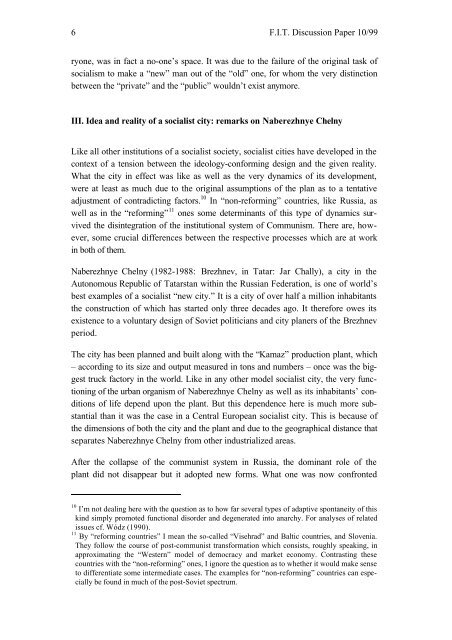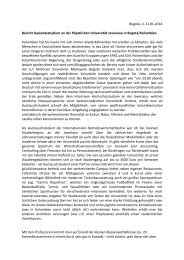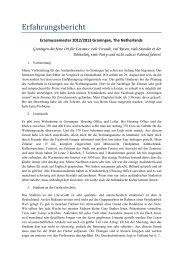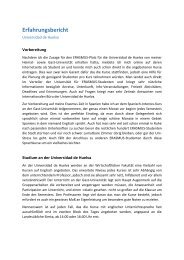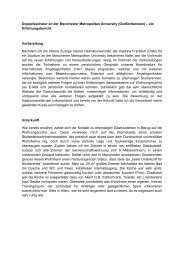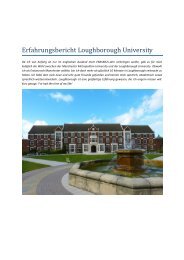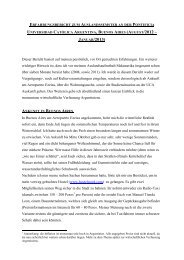Dariusz Aleksandrowicz Aleksandrowicz - Europa-Universität ...
Dariusz Aleksandrowicz Aleksandrowicz - Europa-Universität ...
Dariusz Aleksandrowicz Aleksandrowicz - Europa-Universität ...
You also want an ePaper? Increase the reach of your titles
YUMPU automatically turns print PDFs into web optimized ePapers that Google loves.
6 F.I.T. Discussion Paper 10/99<br />
ryone, was in fact a no-one’s space. It was due to the failure of the original task of<br />
socialism to make a “new” man out of the “old” one, for whom the very distinction<br />
between the “private” and the “public” wouldn’t exist anymore.<br />
III. Idea and reality of a socialist city: remarks on Naberezhnye Chelny<br />
Like all other institutions of a socialist society, socialist cities have developed in the<br />
context of a tension between the ideology-conforming design and the given reality.<br />
What the city in effect was like as well as the very dynamics of its development,<br />
were at least as much due to the original assumptions of the plan as to a tentative<br />
adjustment of contradicting factors. 10 In “non-reforming” countries, like Russia, as<br />
well as in the “reforming” 11 ones some determinants of this type of dynamics survived<br />
the disintegration of the institutional system of Communism. There are, however,<br />
some crucial differences between the respective processes which are at work<br />
in both of them.<br />
Naberezhnye Chelny (1982-1988: Brezhnev, in Tatar: Jar Chally), a city in the<br />
Autonomous Republic of Tatarstan within the Russian Federation, is one of world’s<br />
best examples of a socialist “new city.” It is a city of over half a million inhabitants<br />
the construction of which has started only three decades ago. It therefore owes its<br />
existence to a voluntary design of Soviet politicians and city planers of the Brezhnev<br />
period.<br />
The city has been planned and built along with the “Kamaz” production plant, which<br />
– according to its size and output measured in tons and numbers – once was the biggest<br />
truck factory in the world. Like in any other model socialist city, the very functioning<br />
of the urban organism of Naberezhnye Chelny as well as its inhabitants’ conditions<br />
of life depend upon the plant. But this dependence here is much more substantial<br />
than it was the case in a Central European socialist city. This is because of<br />
the dimensions of both the city and the plant and due to the geographical distance that<br />
separates Naberezhnye Chelny from other industrialized areas.<br />
After the collapse of the communist system in Russia, the dominant role of the<br />
plant did not disappear but it adopted new forms. What one was now confronted<br />
10 I’m not dealing here with the question as to how far several types of adaptive spontaneity of this<br />
kind simply promoted functional disorder and degenerated into anarchy. For analyses of related<br />
issues cf. Wódz (1990).<br />
11 By “reforming countries” I mean the so-called “Visehrad” and Baltic countries, and Slovenia.<br />
They follow the course of post-communist transformation which consists, roughly speaking, in<br />
approximating the “Western” model of democracy and market economy. Contrasting these<br />
countries with the “non-reforming” ones, I ignore the question as to whether it would make sense<br />
to differentiate some intermediate cases. The examples for “non-reforming” countries can especially<br />
be found in much of the post-Soviet spectrum.


